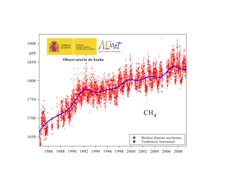CH4 in the atmosphere. The updated Izana’s CH4 record (1984-2009)
CH4 in the atmosphere. The updated Izana’s CH4 record (1984-2009)
Methane (CH4) is the most abundant organic trace gas in the atmosphere. It is also formed and released to the atmosphere by biological processes occurring in anaerobic environments. The CH4 has increased dramatically over the last few centuries and its concentration is now 148% above pre-industrial levels. CH4 is more abundant in the Earth’s atmosphere now than at any time in at least the past 650,000 years (IPCC, 2007). The increasing concentrations of CH4 are of special concern because of its effects on climate and atmospheric chemistry. CH4 absorbs terrestrial infrared radiation that would otherwise escape to space. CH4 is about 25 times more powerful as a greenhouse gas than CO2, but its concentration in the atmosphere is far less (about 1,800 parts per billion –ppb- or 1.8 parts per million –ppm-) compared to 380 ppm in the case of CO2. Nowadays it is accepted that CH4’s climate impact is nearly half that of CO2. However, CH4’s relatively short atmospheric lifetime, coupled with its potency as a greenhouse gas, makes it a candidate for mitigating global warming over the near-term (i.e., next 25 years or so).
Over the past decade, although CH4 concentrations have continued to increase, the overall rate of CH4 growth has slowed, and mainly in the period 1998-2006. CH4 levels rose in 2007 for the first time since 1998. It can be seen in the recently updated Izana’s CH4 data series (NOAA04 scale) that the CH4 mean value is now clearly above 1,800 ppb, and peaks during the annual maxima exceed 1,850 ppb.








